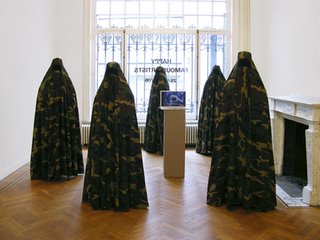When I graduated, a friend gave me a copy of
How to Survive and Prosper as an Artist by Caroll Michels. I read it from cover to cover and still reference it often. She goes into detail about a lot of really important topics - starting a career, pricing your work, creating presentation packets, dealing with galleries, working another job to support your art, etc.
One of the main things that I got out of this book was the way she suggests approaching galleries. Traditionally, you would visit a gallery, talk to the owner or director, and then send them slides of your work later. They would review your slides and then contact you to either say, "No, thanks," or to get more information and possibly represent you.
Michels' approach is a bit different. She suggests creating a brochure that includes information about you and some images of your work. You send this brochure, along with a cover letter, to galleries that you think your work fits into.
I was attracted to this approach because I have a background in graphic design and creating a brochure myself was fairly easy. A brochure is small and easy to mail. The main reason, though is that slides are expensive to duplicate and often galleries will hold your information for months before reviewing and returning it. I didn't want my slides to be damaged or lost or buried under a pile on someone's desk for 6 months.
So I created a small brochure. Folded, it measures 3.5" x 3.5". My work is mostly square, so I wanted to carry the square format through to the brochure. I included my name on the front, over a detail from one of my paintings. Inside, I included images of five more paintings, an exceprt from my artist's statement, my email address and website. On the back, I included an exceprt from my resume that includes my education and a few exhibitions.

I had 2,000 copies professionally printed a little over a year ago. In hindsight, I probably should have only done 1,000, but I think they're general enough to last for another year or so.

So what do I do with them? First of all, I give them to practically everyone I meet. But mostly I send them to galleries.
I mentioned in my post on
calls for proposals that I use the
Art in America museum and gallery guide issue to find university galleries and art centers to which I send proposals. It's also a great resource for finding galleries.
I started at the beginning (they're listed alphabetically by state and city) - I read the description and if it sounds like they exhibit contemporary art, I'll check to see if they have a website. If so, I'll visit the website and look at the work of the artists that the gallery represents. If I can picture my artwork there, I'll then look for any submission guidelines.
Sometimes galleries will post their submission guidelines on their websites. Sometimes they'll say,"We're not taking on any new artists at this time, please don't send us anything." Sometimes they'll have very specific guidelines, "Send 20 slides, resume, and statement. Do not send additional information. Submissions without SASE will be immediately discarded." Seriously. They can get picky.
Follow the guidelines. Galleries get hundreds of submissions and if you don't follow their rules, they won't even consider you.
So I look for galleries that will accept CDs or allow you to email them jpg images of your work or a link to your website.
And if they don't have any guidelines, I'll send them a cover letter and my brochure.
Often I wouldn't hear back, so I started to include a SASE as well. I don't know why, but I'd rather get a rejection letter than not hear from them at all. (I'll rant about rejection letters another time.)
I've gotten a few positive responses from the brochure mailings. I need to count how many I've mailed out and the responses I've gotten back and do some analysis... Anyway, I'm sure there are some old school, traditional gallery types that get my brochure and think, "Why, she's not following the rules!" or "This is stupid." Well, I don't want to deal with those snobby people, anyway, do I?





